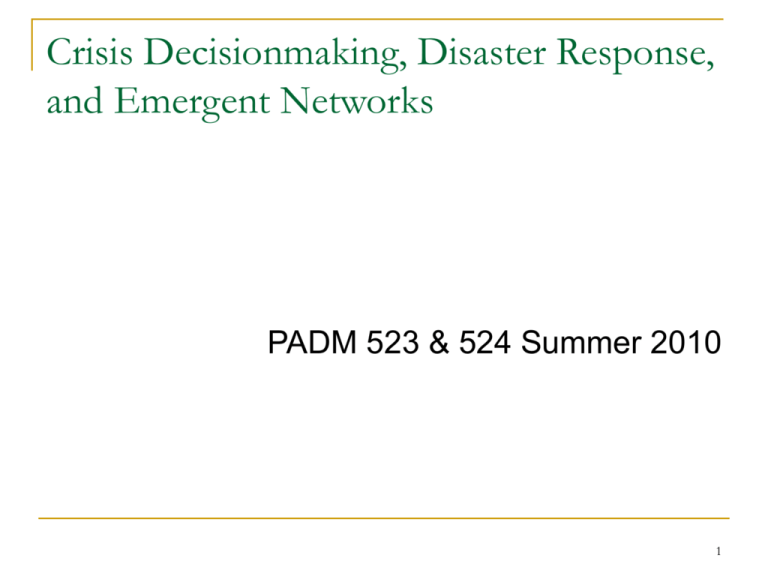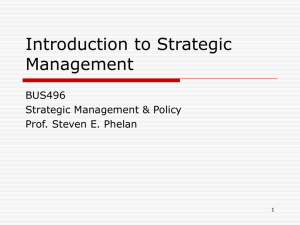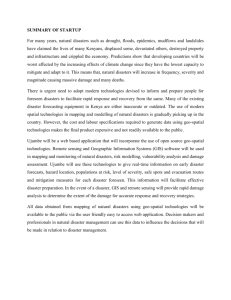524 lecture 2 Katrina crisis decisionmaking & emergent networks
advertisement

Crisis Decisionmaking, Disaster Response, and Emergent Networks PADM 523 & 524 Summer 2010 1 Characteristics Defining a Crisis Crises are defined as situations involving: Threats to major values—high organizational and personal stakes. Time urgency; time pressures. Ambiguity or uncertainty. Surprise or uniqueness. Insufficient information. 1. Jerrold M Post. 1993. “The Impact of Crisis-Induced Stress on Policy Makers,” in Avoiding Inadvertent War, ed. A. George. Boulder: Westview Press. 2. Alan Dowty. 1979. “U.S. Decision-Making Under Stress: 1973,” International Political Science Association. 3. Irving Janis and Leo Mann. 1977. Decision Making: A Psychological Analysis of Conflict, Choice, and Commitment. New York: The Free Press. 2 Crises and Crisis Management Crisis situations are by definition novel, unstructured, and well outside of an organization’s or individual’s customary operating framework. Crises require nonprogrammed decisional responses. Crises are highly uncertain and complex situations. Crises are characterized by an overload of incomplete, conflicting information. The process of perceiving, selecting, and processing this information is critical to effective crisis management Reilly, A.H. 1993. “Preparing for the Worst: The Process of Effective Crisis Management.” Industrial and Environmental Quarterly. Vol. 7, No. 2. Page 118. 3 THE ROLE OF INFORMATION IN CRISIS MANAGEMENT CRISIS ATTRIBUTES (Source: Reilly, A.H. 1993. “Preparing for the Worst: The Process of Effective Crisis Management.” Industrial and Environmental Quarterly. Vol. 7, No. 2.) PROBLEM SENSING EVENT PERCEPTION PROBLEM/THREAT DIAGNOSIS CRISIS MANAGEMENT CRISIS OUTCOMES DECISION RESPONSE RESOURCE MOBILIZATION RESPONSE ACTIONS INTERNAL INFORMATION FLOW DECISIONS AND ACTIONS EXTERNAL INFORMATION FLOW 3 4 Tasks of the Crisis Decisionmaker Define the principal elements of the situation Maintain receptivity to new information Identify and adequately consider the major values, interests, and objectives to be fulfilled Search for and evaluate alternative courses of action Estimate probable costs and risks of alternatives Seek new information pertinent to assessment of options Discern relevant/important from irrelevant/trivial information Consider problems that arise in implementing options Assess the situation from the perspective of other parties Resist both defensive avoidance and premature closure Monitor the developing situation and make adjustments. 5 Characteristics of Defective Decisionmaking in a Crisis—Decisional Dysfunctions A truncated and compressed time span, with much more attention paid to the immediate consequences of action than to long-range consequences; A perceived requirement for decisional closure—i.e., rushed decisions—which may in turn lead to premature action; or, conversely, A tendency toward defensive avoidance, e.g., procrastination; Cognitive rigidity, a tendency to maintain a fixed mind-set and not be open to new information; diminished creativity. A tendency to reduce cognitive complexity and uncertainty; A reduction of the range of options considered; Jerrold M. Post. 1993. “The Impact of Crisis-Induced Stress on Policy Makers,” in Avoiding Inadvertent War, edited by A. George. Boulder, CO: Westview Press. Page 475. 6 Defective Decisionmaking In considering options, a tendency to “bolster,” that is to overvalue and overcommit to factors favor the desired action prescription and devalue and set aside factors militating against that desired course of action. A tendency toward faulty historical analogies; A tendency toward the fundamental attribution bias: To see the other’s actions as being precipitated by internal (psychological) causes rather than external circumstances (example: my adversary’s actions show that s/he is malevolently out to destroy us, rather than that s/he responding to external threats; demonization, caricature. With sustained cognitive conflict and increasing value conflict, there is a tendency toward the emotional loading of chosen options: Choices are often rationalized by such statements as “We've run out of options,” when in fact good options remain to be considered. 7 PERFORMANCE/STRESS CURVE Source: Post, Jerrold M. 1993. “The Impact of Crisis-Induced Stress on Policy Makers.” PERFORMANCE 8 Decisionmaking Patterns Vigilance – follows a methodical, high-quality process to objectively collect available information, thoroughly consider it, search for other possible options, and make a well reasoned decision. Unconflicted adherence – continuing with the current situation. Unconflicted change – following the last advice received. Defensive avoidance – avoiding decision making. Hypervigilance – The Inability to distinguish (or discern) the critical or crucial from the unimportant; equal attentiveness to all stimuli; undifferentiated scanning; leads to a vacillating approach. Source: Fink, Steven. 1986. Crisis Management: Planning for the Inevitable. New York: Amacom. Pages 133–150. 9 A Definition of “Groupthink” “a mode of thinking that people engage in when they are deeply involved in a cohesive in-group…members’ striving for unanimity override their motivation to realistically appraise alternate courses of action… a deterioration of mental efficiency, reality testing, and moral judgement that results from in-group pressures.” Source: Neck, C.P., and Manz, C.C. 1994. “From Group Think to Teamthink: Toward the Creation of Constructive Thought Patterns in Self-Managing Work Teams.” Human Relations. Vol. 47, No. 8. Derived from Victims of Groupthink, by I.L. Janis (Boston: Houghton Mifflin. 1972). Page 9 in Groupthink. 10 Antecedent Conditions for “Groupthink” Primary: A moderately or highly cohesive group. Structural or administrative faults in the organization in which the group exists, including: Insulation of the group. The group leader’s preference for a certain decision. A lack of norms requiring methodical decisionmaking procedures for the group. Homogeneity of the group members’ social background and ideology. High stress from external threats with low hope of a better solution than the leader’s solution—based in turn on over-reliance on the leader and his or her framing of situations. Relatively low levels of group self-esteem, often induced by the group’s perception of recent failures, excessive difficulty of current decisionmaking tasks, and moral dilemmas (for instance., apparent lack of feasible alternatives except ones that violate ethical standards). Source: Neck, C.P., and Manz, C.C. 1994. “From Group Think to Teamthink: Toward the Creation of Constructive Thought Patterns in Self-Managing Work Teams.” Human Relations. Vol. 47, No. 8. Derived from Victims of 11 Groupthink, by I.L. Janis (Boston: Houghton Mifflin. 1972). Pages2 and 3. Symptoms of “Groupthink” Direct social pressure placed on a member who argues against the group’s shared beliefs. Members’ self-censorship of their own thoughts or concerns that deviate from the group consensus. An illusion of the group’s invulnerability to failure. A shared illusion of unanimity. The emergence of self-appointed mind guards that screen out information from outside the group. Collective efforts to rationalize. Stereotyped views of potential adversaries outside the group. Unquestioned belief in the group’s inherent morality. Source: Neck, C.P., and Manz, C.C. 1994. “From Group Think to Teamthink: Toward the Creation of Constructive Thought Patterns in Self-Managing Work Teams.” Human Relations. Vol. 47, No. 8. Derived from Victims of Groupthink, by I.L. Janis 12 (Boston: Houghton Mifflin. 1972). Page 3. Correlative Symptoms of Defective Decisionmaking Incomplete survey of alternatives. Incomplete survey of objectives. Failure to examine risks of preferred choices. Failure to reappraise initially rejected alternatives. Poor information search. Selective bias in processing information at hand. Failure to work out contingency plans. Source: Neck, C.P., and Manz, C.C. 1994. “From Group Think to Teamthink: Toward the Creation of Constructive Thought Patterns in Self-Managing Work Teams.” Human Relations. Vol. 47, No. 8. Derived from Victims of Groupthink, by I.L. Janis (Boston: Houghton Mifflin. 1972). Page 3. 13 Decisional Limits in Disaster Response Research shows that while authority, leadership, and accountability are necessary in any event, collaboration functions better than over-centralized command and control approaches in major crises (Drabek & McEntire, 2002). Complex disasters necessitate decentralized decision making structures and collaborative networks of exchange and support. A decentralized network will often emerge in the post-event environment of a large-scale disaster. The challenge is to maximize collaboration and communication across that network. Disasters disrupt the patterns of what can be absorbed by routine procedures. As Tierney (2002) states, these types of events are largely defined by the need for improvised responses—but not entirely improvised. Rather, emergent organization shapes responses based on a combination of experience & improvisation. – Drabek T. E. and D.A. McEntire. 2002. Emergent Phenomena and Multi-organizational Coordination in Disasters: Lessons from the Research Literature. International Journal of Mass Emergencies and Disasters. August, 22(2), 197-224. – Tierney, K.J. 2002. “Lessons Learned from Research on Group and Organizational Responses to Disasters.” Paper presented at Countering Terrorism: Lessons Learned from Natural and Technological Disasters. Academy of Sciences, February 28 – March 1 14 Incident Management Systems “A generic term for the design of ad hoc emergency management teams that coordinate the efforts of more than one agency under a unified command” (p.1) A functional management system that integrates personnel from different home organizations Involve identification of an incident manager or unified management team when jurisdictional areas or responsibilities overlap Standard terminology facilitates cooperation (although some minor regional variance remains) Rules for chain of command, unity of command, and span of control Protocols for communications and flow of information Emphasis on logistics planning and centralized resources allocation Planning functions on an equal level with operations and logistics functions Christen, H., P. Maniscalco, A. Vickery, and F. Winslow. 2001. “An Overview of Incident Management Systems.” Perspectives on Preparedness. Executive Session on Domestic Preparedness. No. 4 (September). 15 Emergent Organization in Disaster Response Even with IMS in place, disasters evoke emergent responses. “Emergence is likely when members perceive a present threat, when the social climate is supportive of emergence, when social ties are in place – at least to some degree – before the mobilization, when the social setting legitimizes the groups, and when resources are available (Quarantelli et al., 1983).” This is so given that major disasters—catastrophes—involve situations where: Most or all of the community built structure is heavily impacted...[and] the facilities and operational bases of most emergency organizations are themselves usually hit Local officials are unable to undertake their usual work role, and this often extends into the recovery period Help from nearby communities cannot be provided Most, if not all, of the everyday community functions are sharply and concurrently interrupted The mass media system, especially in recent times, socially constructs catastrophes even more than they do disasters Because of the previous five processes, the political arena becomes even more important “…[Therefore] the level of emergence necessary to contend with these severe and unanticipated conditions is likely to be greater than would occur in more typical disaster situations.” Quarantelli, E.L., with K.E. Green, E. Ireland, S. McCabe, and D.M. Neal. 1983. Emergent Citizen Groups in Disaster Preparedness and Recovery Activities: An Interim Report. Newark DE. University of Delaware, Disaster Research Center. 16 Emergent Networks Emergent Multi-Organizational Networks (EMONs): The “structure of relationships that form among organizations, or segments of organizations, that are focused on a specific [activities or response functions]” (Drabek, 1996: 21-11) Form during the emergency period for a limited time in order to address emerging needs In catastrophic events, EMONS are often simultaneously comprised of a range of established, expanding, extending, and emergent organizations. Emergent organizational networks are defined as such not necessarily because they are comprised of emergent groups, but because of the newly formed relations between organizations Drabek, T.E. 1996. The Social Dimensions of Disaster. Washington, DC: Federal Emergency Management Agency. 17 Emergent Groups: Benefits and Challenges May be able to act more quickly as they are outside of a formal bureaucracy May have a better pulse of what emerging needs are as they connected to emergent systems and networks May meet needs unidentified or not being met by formal systems May not be governed by the same standards or systems of oversight as formal organizations May have less of a feel for emerging needs as they not necessarily part of the formal network where certain information is directed to May generate overlap and compete with existing systems May be characterized by unclear leadership May have unstable definitions of tasks and roles Drabek, T.E. and D.A. McEntire. 2003. Emergent Phenomena and the Sociology of Disaster: Lessons, Trends and Opportunities from the Research Literature. Disaster Prevention and Management, 12(2): 97-112. 18 Role of Personal Convergence in Emergent Groups and Networks Personal or people convergence involves the influx of people to areas associated with the disaster milieu (Kendra & Wachtendorf, 2003; Fritz & Mathewson, 1957). - Fritz, C. and J. H. Mathewson. 1957. Convergent Behavior: A Disaster Control Problem. Special Report for the Committee on Disaster Studies. National Academy of Sciences, Washington, D. C. - Kendra, James M., and Tricia Wachtendorf, 2003. Reconsidering Convergence and Converger Legitimacy in Response to the World Trade Center Disaster. Terrorism and Disaster: New Threats, New Ideas (ed. Lee Clarke). Research in Social Problems and Public Policy (11), 97-122. 19 Network Visibility As existing groups take on new roles or other groups emerge, information about key organizations is often not known across the social network. In catastrophic events where convergence and emergence may play an even larger role than in typical disasters, network visibility, which allows for both open and coordinated systems, becomes paramount. Networks need to take visible form so that communications and role and task structuring can begin to take shape as well. - Wachtendorf, T., B. Brown, J. Holguin-Veras, and S. Ukkusuri, and Perez. (In preparation). Network Visibility in Emergency Supply Chain Management. 20 In the aftermath of Hurricane Katrina, emergent groups— previously existing groups undertaking new tasks or with new organizational arrangements—and established organizations all formed new organizational networks as they contended with the many response needs. Some groups played more dominant roles than others in different stages of the response and early recovery, with respect to different tasks, and in working with different communities. Some activities, such as Coast Guard search-and-rescue were so pre-programmed and at the same time apt for the situation at hand, that they were immediately deployable, and they also formed nuclei for the self-organization of emergent responses. 21 Katrina Experience—Decisional failures Lack of adequate plans for things like evacuation Flawed local planning process Loss of local command and control facilities Lack of coordination among organizations of all types: volunteers in boats and buses, Coast Guard, Red Cross, medication Lack of initiative, as in the waste of city buses which could have been mobilized for evacuation and instead ended up under water. Lack of creativity or resilience, as in the instance of refusal of Amtrak’s offer to fill its last train out of the city with evacuees Lack of expertise Governor’s refusal to nationalize National Guard; political pettiness. 22 22 Strategic View of Disaster Response Defining, articulating: What is the nature and scope of the emergency? What are the values involved (those threatened and those in prospect)? What operational capabilities* and resources are required? *Capability = organizational capacity + individual skill & experience Strategic managerial leadership: individual and systemic What authorizers & resources need be involved, and aligned? White House, FEMA, Governor, Mayor, Red Cross, etc. 23






![Annex-1 Country Report Format [Word/27KB]](http://s3.studylib.net/store/data/007746618_2-5274716d2b8745578e5f33948d9d09db-300x300.png)